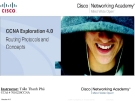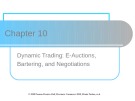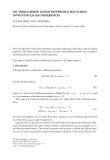
Describe forward
-
Describe the basic purpose of a router – Computers that specialize in sending packets over the data network – They are responsible for interconnecting networks by selecting the best path for a packet to travel and forwarding packets to their destination Routers are the network center – Routers generally have 2 connections: • WAN connection (Connection to ISP) • LAN connection
 408p
408p  phutran76
phutran76
 03-05-2012
03-05-2012
 146
146
 44
44
 Download
Download
-
Lecture Electronic commerce - Chapter 10: Dynamic Trading: E-Auctions, Bartering and Negotiations learning objectives: Define the various types of e-auctions and list their characteristics. Describe forward and reverse auctions. Describe the benefits and limitations of e-auctions. Describe some unique e-auction models. Describe the various services that support e-auctions.
 41p
41p  caphesuadathemtac
caphesuadathemtac
 09-11-2021
09-11-2021
 17
17
 4
4
 Download
Download
-
Inspired by Lorenz’ remarkable chaotic flow, we describe in this paper the structure of all C 1 robust transitive sets with singularities for flows on closed 3-manifolds: they are partially hyperbolic with volume-expanding central direction, and are either attractors or repellers. In particular, any C 1 robust attractor with singularities for flows on closed 3-manifolds always has an invariant foliation whose leaves are forward contracted by the flow, and has positive Lyapunov exponent at every orbit, showing that any C 1 robust attractor resembles a geometric Lorenz attractor. ...
 59p
59p  tuanloccuoi
tuanloccuoi
 04-01-2013
04-01-2013
 57
57
 9
9
 Download
Download
-
ON THIRD-ORDER LINEAR DIFFERENCE EQUATIONS INVOLVING QUASI-DIFFERENCES ˇ ´ ˇ ZUZANA DOSLA AND ALES KOBZA Received 30 June 2004; Revised 20 September 2004; Accepted 12 October 2004 We study the third-order linear difference equation with quasi-differences and its adjoint equation. The main results of the paper describe relationships between the oscillatory and nonoscillatory solutions of both equations. Copyright © 2006 Hindawi Publishing Corporation. All rights reserved. 1.
 13p
13p  sting12
sting12
 10-03-2012
10-03-2012
 31
31
 4
4
 Download
Download
-
In Chapter 23, we introduced the basic technologies and architectures developed by the IETF in the conferencing area. In this chapter, we discuss how those technologies are used in the IMS to provide a conferencing service. This chapter is fairly brief because applying the technologies described in Chapter 23 to the IMS architecture is relatively straight-forward.
 4p
4p  0984272663
0984272663
 27-04-2011
27-04-2011
 83
83
 9
9
 Download
Download
CHỦ ĐỀ BẠN MUỐN TÌM

















